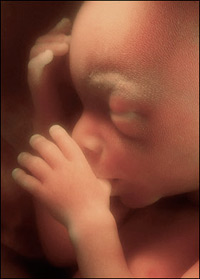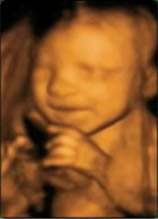Is it okay to use the term “fertilized egg”?
Not if you’re referring to human beings after conception.
The problem lies in how the words are used. Fertilization is an initiating process – a verb. With humans, it is not an end state of that process. People are born – not hatched, so the gestational environment (egg) that avians require is not the same needed by mammals*. If a human egg (oocyte) is fertilized (undergoes that process) it is no longer an egg. It is transformed. It changes its state of being.
Human Embryonic Stem Cell Research (HESCR) and abortion proponents play word games, using a valid phrase “fertilized egg”, but fallaciously redefine the meaning to a thing which exists after the process is finished. It’s only valid to say it’s a “fertilized egg” between the time the zona pellucida has been penetrated until amphimixis is complete – at which point you have a zygote – a one cell human being. The actually process of fertilization is no longer occurring to an egg – which has been transformed.
 Here’s an illustration to clarify:
Here’s an illustration to clarify:
Someone is holding a glass of water. We could say – that’s a melted ice-cube, and understand that at some point prior to our immediate observation an ice-cube as an object was in the glass.
But would we talk about drinking a melted ice-cube as though the cube still existed?
Now we’re going to extract a few drops from this “melted ice-cube”. Where’s the ice-cube? It’s not an ice-cube anymore. The ice-cube has ceased to be.
Now let’s take our illustration one step further. Suppose while holding the glass of “melted ice-cube”, the “melted ice-cube” started to grow, filling up the glass on it’s own. Where’s the ice-cube now?
Melting is a process that transforms the state of water from a solid to a liquid. At the end of melting, there is no identifiable object “ice-cube”. We can only understand it as having existed at the time of the transformation, but not after.
The same thing applies to eggs and fertilization. Human eggs are not self governing “growing” organisms – but that describes living human beings.
The Endowment for Human Development (EHD) appears to have solid neutral information on human development and the zygote.
The next time someone refers to a “fertilized egg” ask them a simple question: “Do you mean after conception – when the pronuclei have fused?” (Or you could ask them if they were hatched…)
It might lead to a discussion about when we become human beings.
Note: When writing this post I was quite surprised at how many professional organizations used the term “fertilized egg” when referring to a human zygote. Would they be upset if others called them “fertilized eggs”?
*Okay – so the platypus is a mammal that lays eggs. Humans are not platypus.
Related Posts:
Common Evidence – What is it?

 The Bostonians were late to the party – in 1772 Rhode Islanders decided upon a more radical protest of taxation: they burned the
The Bostonians were late to the party – in 1772 Rhode Islanders decided upon a more radical protest of taxation: they burned the 
 If the unborn is growing, it must be alive. And if it has human parents, it must be human. And living humans, or human beings like you and I, are valuable aren’t they? From conception, all that’s added to the unborn is a proper environment and adequate nutrition. But those are the same things all of us need. And not only that. There’s one quality all of us have equally that demands equal treatment: we all have a human nature. Racism and sexism are wrong because they pick out external differences and ignore the underlying similarity between men and women, blacks and whites. And my concern is for your rights as a woman, that you can vindicate them against the will of the majority, but you can only vindicate your rights if you base them on your human nature. But the unborn also has that same human nature, so shouldn’t we protect him from discrimination just like we protect minorities and women?
If the unborn is growing, it must be alive. And if it has human parents, it must be human. And living humans, or human beings like you and I, are valuable aren’t they? From conception, all that’s added to the unborn is a proper environment and adequate nutrition. But those are the same things all of us need. And not only that. There’s one quality all of us have equally that demands equal treatment: we all have a human nature. Racism and sexism are wrong because they pick out external differences and ignore the underlying similarity between men and women, blacks and whites. And my concern is for your rights as a woman, that you can vindicate them against the will of the majority, but you can only vindicate your rights if you base them on your human nature. But the unborn also has that same human nature, so shouldn’t we protect him from discrimination just like we protect minorities and women? I was browsing through twitter follow lists the other morning and found someone joking about birth control pills being cheaper than children. Of course most people laugh when they hear such things, because parents know the expense of raising children. We often comment on the amount of time, treasure and talent it takes to raise them properly.
I was browsing through twitter follow lists the other morning and found someone joking about birth control pills being cheaper than children. Of course most people laugh when they hear such things, because parents know the expense of raising children. We often comment on the amount of time, treasure and talent it takes to raise them properly.